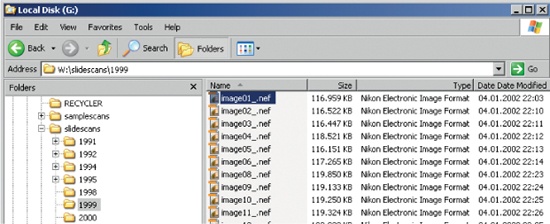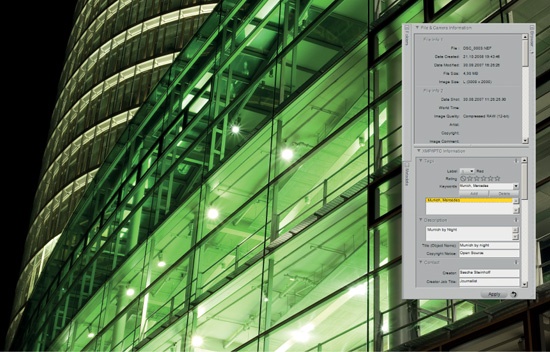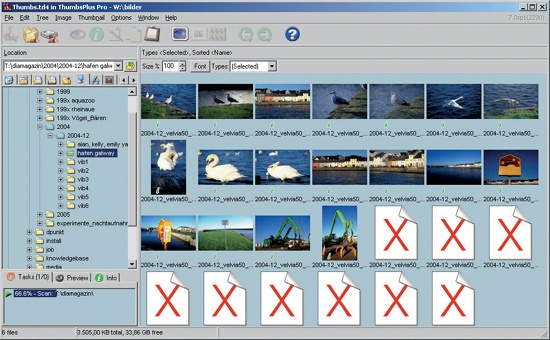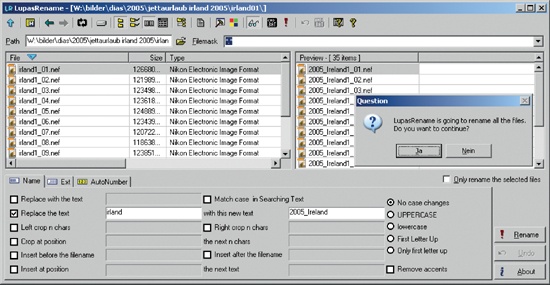For managing a large number of digital images, simple image browsers such as Nikon Capture or Photoshop are not sufficient. Programs such as ThumbsPlus or iMatch offer far more powerful cataloging functions.
The first step in setting up an image database in a meaningful way is to construct a logical folder structure. If you scan slides as well as negatives, the directory tree on your hard disk should factor in the structure of your analog archive. This will help you to associate a file easily with the analog original. For a rescan, you will not have to search very long to find the correct slide or filmstrip. The following information can help simplify retrieval:
Year of shooting (e.g., 2005)
Month and day of shooting (e.g., 08-27)
Unique naming of the film with sequential numbering (e.g., F001)
Film strip number or position in the slide tray (e.g., 36A)
Occasion (e.g., Wedding André/Dani)
Note
*A well-planned folder structure is usually sufficient if you want to index a small photo archive. This way you can save yourself the effort of individually annotating your images with IPTC keywords.
This type of information should be reflected in the folder tree of the hard disk, the IPTC information of the images, and the filing system of the physical film archive. A well-structured filing system speeds up your search. In addition to the logical directory structure, you can include key information such as the date in the file name. If you move or copy files, this type of naming convention makes it easy to reconstruct the origin of those files. With this method, you will notice errors immediately when moving files. A file name such as 2004-10-Film01-Cliffs-Neg12.nef is much more descriptive than IMG12.nef (as generated by default in Nikon Scan).
There are no hard and fast rules for organizing your photo archives. A good yardstick is how long it takes a stranger to understand your system. The easier your system is to understand, the better it is.
Note
Batch Editing IPTC Information To manage an archive, it can be tedious to enter IPTC image data for each image one-by-one. In an image sequence, much of the data can be repeatedly used for several images. With Nikon Capture, information for multiple images can be filled out at once. This function is somewhat hidden under Batch/Copy IPTC Info. It allows the IPTC entries of one image to be copied and subsequently applied to the target images with Batch/Paste IPTC Info.
Some labels can be applied to an image with appropriate file naming conventions based on file and folder structure. However, quite often there is a need for additional information about images, such as:
Who the photographer is; who owns the image rights
Where and when the picture was taken
What film type was used; what camera equipment was used
This list of metadata – data about data – could be extended infinitely. Metadata describe the image in as detailed a fashion as possible. For this purpose, text information is added to the image information and stored in the image file. The International Press and Telecommunication Council has adopted the IPTCNAA standard, or IPTC for short. Not all image file formats support this metadata entry. Suitable image databases, such as iMatch, offer quick searching of large numbers of files for a particular image.
The quality of the search depends on the quality of the IPTC metadata. A keyword search works only if each image file has the corresponding entry in its IPTC header. Many viewers and most image editors support IPTC for the standard formats JPEG and TIFF. The support for NEF format, however, is not as good. IPTC data can only be edited by programs that have full access to NEF, such as Capture NX2.
In order to manage a large number of images efficiently, you need a good viewer with a thumbnail indexing function and its own image database, such as ThumbsPlus. Common viewers lack these functions. Nikon View, for example, generates the thumbnails anew each time it opens a folder. If you frequently jump between folders, the long wait required to generate thumbnails will test your patience. Especially for large scan files, the wait is considerable. ThumbsPlus solves this problem by generating the thumbnails only once: when the folder is opened the first time.
To do that, ThumbsPlus searches for all image files on the hard disk, generates thumbnails, and stores them in a separate database. This process takes some time, but it runs in the background while other work continues on the PC. Once the thumbnail index is complete, you can open a folder and immediately see the thumbnails. If you delete a file with ThumbsPlus, it updates the thumbnail database accordingly. If you delete images with a different program, such as Windows Explorer, ThumbsPlus needs to regenerate the index to keep the database up-to-date.
RAW Support in Viewer Applications
Only a few viewers support RAW in their basic version. To display NEF files in ThumbsPlus, you need the Digicam RAW Plug-In. This plug-in for ThumbsPlus is noticeably slower than Nikon View NX for full-screen display of NEF files. If you use ThumbsPlus for managing NEF files, but use Nikon View NX for viewing individual images, you can combine the advantages of both programs quite nicely.
If you reorganize your folder and file structure, you may have to rename multiple files. With Windows Explorer this can be tedious, since you have to do it one by one. LupasRename is a lean tool for simple batch renaming. This freeware is available at http://rename.lupasfreeware.org. It helps if the files are already numbered sequentially. The names should contain a number that corresponds to the analog original. For example, Negative #21 would best be saved as IMG21.tif, so that you can keep the default names during scanning. Once the final name is found, you can rename it with LupasRename. This tool supports all data formats, since it does not write into the file itself.




